Rev Yaakov Moshe Raphall
יעקב משה ב"ר רפאל
Spiritual Leader, Congregation B'nei Jeshurun , New York CityDate of Death:
Tue. June 23, 1868 -
Tammuz 3 5628
Anyone with biographical information is asked to please send it in.
See CONTACT page for details. Thank you.
Directions to Kever: The Beth Olam Cemetery is located on the Eastern side (towards Queens) of the Jackie Robinson Parkway on the Cypress Hills / Ridgewood border in Queens. The cemetery is kept in pristine condition however, unfortunately their records are in total disarray and paths are not well marked. Location: Second entrance (coming from the Jackie Robinson Parkway) , after cul-de-sac, enter path between section 21 and 22 (Dessau and Russak), proceed until Sommers tombstone and go left down path (same path as the Mitchell mausoleum) third grave in.), Section: 11, Lot: 8, Grave: G
Name Listed on Cemetery Database: Rev Morris Jacob Raphall
Biographical Notes:
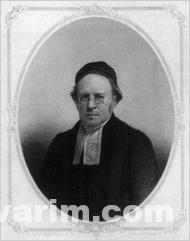
Photo Caption: Rev Morris Jacob. Raphall, c. 1860, Credit: Library of Congress
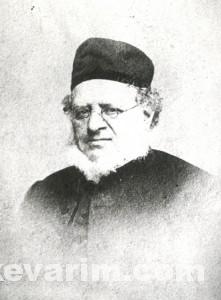
Photo Credit: Rev Morris Jacob. Raphall, Credit: American Jewish Archives
Bio Information:
Rev Moshe Yaakov (Morris Jacob) Raphall was born in Stockholm, Sweden in 1798. At the age of nine his father, a banker, took him to visit the King of Sweden and then to Copenhagen , where he was educated at the Hebrew grammar-school. He later received a Ph.D. degree from the University of Erlangen (Germany). Soon after, he began publishing the Hebrew Review and Magazine of Rabbinical Literature.
In 1840, when the blood accusation was made at Damascus, he published a refutation of it in four languages (Hebrew, English, French, and German) and wrote a defense of Judaism against an anonymous writer in the London Times. The Rev also published a translation of eighteen treatises of the Mishnah; he also began a translation of the Pentateuch, of which only one volume appeared; and a text-book of the post-Biblical history of the Jews (to the year 70 C.E.).
In 1841 he was appointed Moreh Dasrah (minister) of the Birmingham Synagogue (West Midlands), United Kingdom, and the Rosh Yeshiva (head master) of the school. He continued in these capacities for eight years, and then sailed for New York where he was appointed rabbi and preacher of Congregation B’nei Jeshurun. He passed away in New York on June 23, 1868.
« Previous: Rebbe Chaim FriedlanderNext: Rabbi Elozer Meisels »

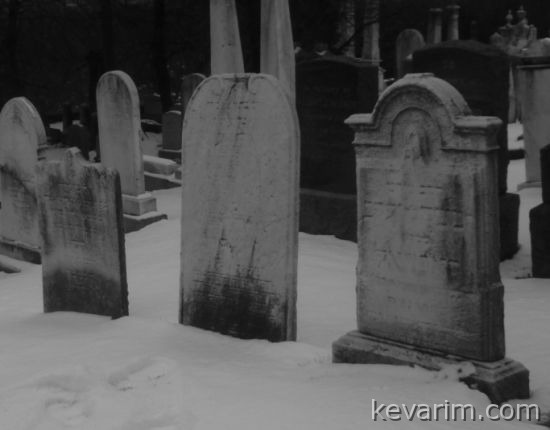

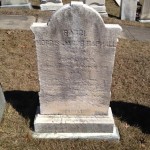

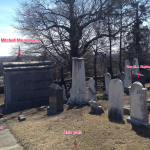

I am grateful to Harold Goldman, the Executive Director and Ron Seitenbach, the Director of Finance of Congregation B’nai Jeshurun for helping me find the Rav?s kever.
Thank you,
From the picture it looks like his name was Moshe b. Yaakov?
B”H that you found the Rav kever, Rav Raphall was among the fierce protectors of true torah values in his day.
The Rav came to the United States in 1849 and was the first Rabbi to open a session of the US House of Representatives with a prayer (1860).
Kudos on locating his kever.
I was there this morning, the path is also marked off in yellow.
Rabbi Raphall caused a stir when he gave a speech titled The Bible View of Slavery in New York on January 15, 1861, because he defended the institution of slavery. See
http://www.jewish-history.com/civilwar/raphall.html
Shortly after this speech others attempted to refute his position. See
http://www.jewish-history.com/civilwar/heilprin.html
I just came across this posting on another website (nah there are other websites!!!!!) apparently there was an Ashkenazi custom back in the day that a person would use his fathers name as a second name in addition to the family name. Some examples are Rav Shamshon Raphael Hirsh was really Shamshon b. Raphael Hirsh, Rav Nosson Markus Adler (Chief Rabbi of England) was Nosson b. Markus. This would explain why Rabbi Moshe b. Yaakov Raphall was comenly known as Rabbi Morris Jacob Raphall.
Does anyone have any idea as to the origins of this custom or if it is still practiced?
A clearer shot:
http://s949.photobucket.com/albums/ad339/aman51/Beth%20Olam%20Cemetery/?action=view¤t=Raphall.jpg
Consecration of a Jewish Synagogue.; THE NEW PLACE OF WORSHIP OF THE CONGREGATION, B’NAI ISRAEL.
Published: August 6, 1860, New York Times
The consecration of the new synagogue of the congregation B’nai Israel, located on the corner of Stanton and Forsyth streets, took place yesterday afternoon. The building, which is capable of holding about 800 people, was formerly a Baptist Church, but has recently been purchased, and converted into a synagogue by the above congregation, most of whom are natives of Holland. The interior transformations required to convert it into a synagogue were not extensive or costly — the only change being a shifting of the position of the pows, so as to leave a space for the “reading desk” in the centre of the church, and the erection of a semioircular ark in the place of the pulpit. The reading desk is the same as that used in the old synagogue of this congregation, in Christie-street, made of rosewood, and surrounded by an inclosure, or railing, about ten feet square, and of elegant workmanship. On the four corners of the inclosure are gas fixtures, in imitation of candies, and over head depends a magnificent bronze chandelier, with numerous jets, all of which were kept burning during the consecration service. The “Ark” is also made of rosewood, with sliding doors, and, when closed, is screened from public view by rich damask curtains, which were presented by the ladies of the congregation.
The synagogue was filled to its utmost capacity, yesterday, by an audience composed about equally of ladies and gentlemen. As the congregation B’nai Israel is among the strictest of the “orthodox” party of the Jews, and opposed to the modern “improvements” and “reforms” that have been introduced into some other synagogues, the old customs, seating the sexes apart, was adhered to, and the ladies occupied the gallery, while the gentlemen sat in the body of the church.
Among the Jewish clergy of other congregations present were Rev. Dr. RAPHALL, of the Greene-street Synagogue; Rev. S.M. ISAACS, of the Wooster-street Synagogue; Rev. J.J. LYONS, of the Portuguese Synagogue, and Rev. Mr. BENDI.
The ceremonies of the consecration were arranged and conducted by Rev. M.R. DELEEUW, the minister of the congregation B’nai Israel.
The consecration service opened with a chant from the choir, which occupied the inclosure surrounding the reading-desk, and was led by the minister of the congregation. The trustees of the synagogue then entered bearing the “sacred scrolls,” and preceded by twenty-four young girls, dressed in white, with blue scarfs, and each one carrying in her band a basket of flowers. The trustees took their position in the open space, between the reading-desk and the ark, and were flanked on either side by a column of the young girls, who commenced picking flowers from their baskets and throwing them at their feet, while the choir chanted a dedication psalm. The bearers of the sacred scrolls, accompanied by the honorary officers of the church, men marched in procession seven times around the synagogue, each circuit being accompanied by an appropriate chant from the choir. On each return of the procession to the open space fronting the ark they were pelted with roses from the fair hands of the young misses until the ground was literally covered with these fragrant floral offerings. The seventh circuit having been completed, the ark was opened, the sacred scrolls were deposited therein, the doors were closed, the damask curtains were drawn close around it, and the perpetual lamp which depends from the ceiling in front was ignited, never to expire.
After another chant from the choir, Rev. Dr. RAPHALL ascended the platform on which rests the ark, and addressed the congregation in a few remarks befitting the occasion, taking for his text the passage of Scripture commencing, “How beautiful are thy Tabernacles, O Lord of Hosts.” He alluded to the persecutions which the children of Israel had suffered under the Roman Empire, and all through the middle ages, even to the time when they crossed the ocean and landed in this home of freedom and equality. He spoke of the progress of the congregation B’nai Israel, from the time when he first addressed them in their Synagogue in Pell-street until now, and exhorted them to renewed devotion and praise to the Lord for the prosperity that had attended them.
Rev. Drs. ISAACS and BENDI also briefly addressed the audience.
Who was the Rav in Cong. B’nai Israel?
Rabbi Raphall had 3 children:
1. His son Major Alfred Morris Raphall who served in the civil war where he was severely wounded and was later appointed Commercial General to Mexico where he died in 1903
2. A daughter Mrs. Esther C. Levy of Washington
3. A daughter Mrs. Bella Cohen of Chicago
http://chroniclingamerica.loc.gov/lccn/sn83045462/1903-10-15/ed-1/seq-16/#date1=1836&index=5&rows=20&words=Rabbi+Raphall&searchType=basic&sequence=0&state=&date2=1922&proxtext=Rabbi+Raphall&y=-221&x=-941&dateFilterType=yearRange&page=1
The Daughter Esther C. levy was the wife of Captain Cherrie M. Levy, she died September 30 1911 in Washington:
http://chroniclingamerica.loc.gov/lccn/sn83045433/1911-10-01/ed-1/seq-2/#date1=1836&index=4&rows=20&words=Morris+Raphall&searchType=basic&sequence=0&state=&date2=1922&proxtext=Morris+Raphall&y=-221&x=-941&dateFilterType=yearRange&page=1
Bar Mitzvah of Rabbi Raphalls’s grandson on the B’Nai Yeshurun Shul:
http://query.nytimes.com/mem/archive-free/pdf?res=F10E1EFA395E1A7493C6A81788D85F4D8684F9
So fascinating! We did a project about him and it would be coool to go to his keiver. Does anyone know of descendants that are alive today?